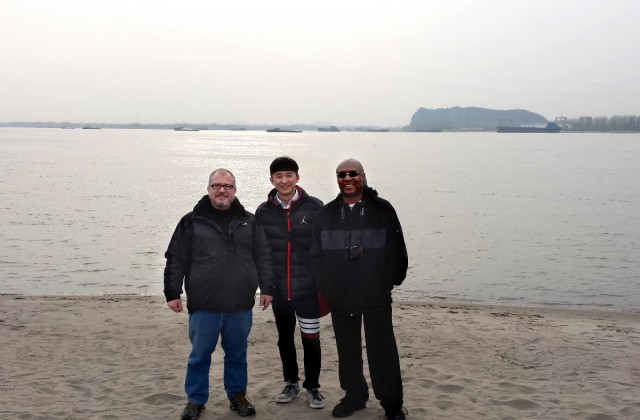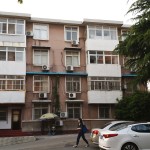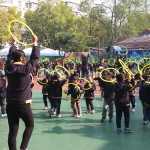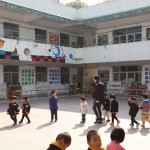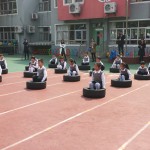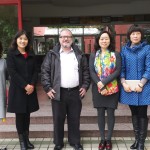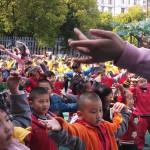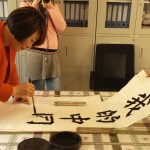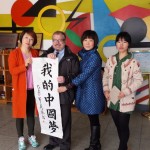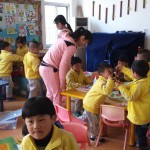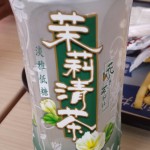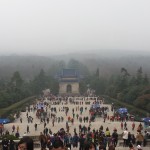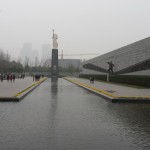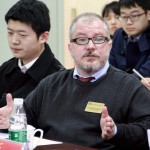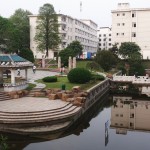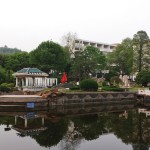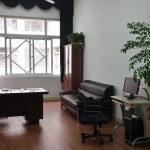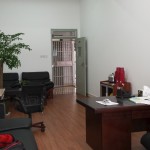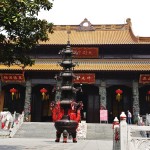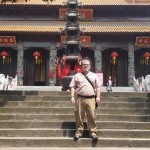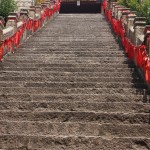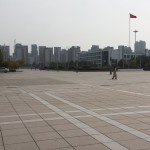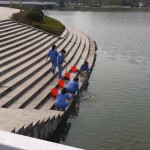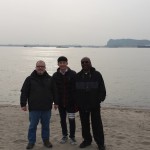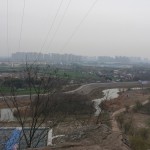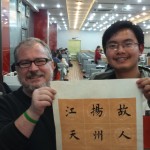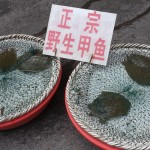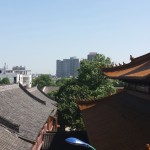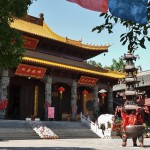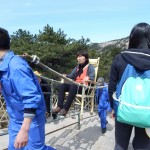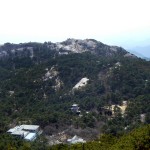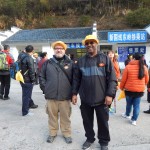From Lake Lanier to the Yangtze River
Longtime Brenau professors Dr. Bryan Sorohan and Dr. Eugene Williams had an opportunity to visit one of the most prestigious colleges in China earlier this year. Under Brenau’s ‘two plus two’ partnership program with Anhui Normal University, more faculty and students – on and off campus – are set for similar international learning experiences.
The Chinese language consists of about 50,000 characters. Those who know 8,000 are regarded as well-educated, while knowledge of 2,000 is largely considered the bare minimum one needs to get by in daily life.
When Dr. Bryan Sorohan visited the world’s most populous country last spring, he knew zero.
“That was my first experience as an adult living in an environment where I was totally illiterate,” he says. “It’s not even like in Europe, where you can at least try to determine what an unknown word means.”
The 11th-year Brenau professor spent about three months in Wuhu, China, as part of a faculty exchange with Anhui Normal University. The same arrangement brought Anhui professors Lixin Zhu and Yan Zhou to the historic Gainesville campus in the spring 2015 term.
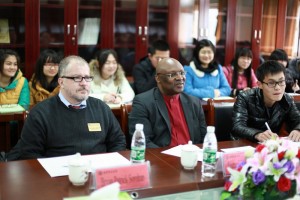
Last year, Brenau announced a “two-plus-two” partnership with Anhui. The program allows early education childhood teaching majors to transfer to Brenau’s historic Gainesville campus after two years of study in China. Joint programs of the like are not common. In fact, the Chinese government only approved about 30 percent of two-plus-two applications submitted from 2011 to 2014.
Although Sorohan says residing in a city of 3 million people and teaching at a university with more than 30,000 students – without the benefit of knowing the native language – was somewhat daunting, it was nonetheless a remarkable experience.
He taught two English courses, a reading and research writing unit and an oral communication class, to about two dozen Anhui freshmen. He also took the helm of two additional School of Foreign Studies lecture series, which – in a sharp contrast to Brenau’s smaller class sizes – numbered well over 150 undergraduate and graduate students.
While all of the Anhui students demonstrated a firm grasp of the English language, Sorohan says there were some cultural barriers to cross. Many of the same reference points he uses in Brenau classes were unfamiliar to Anhui’s students and he had to overcome a “big social gulf” in professor-to-pupil communication.
“In Chinese culture, teachers rarely have social contact with students outside of the classroom,” he says. “You have to work a little bit to create an atmosphere like you’d find in an American school, where students feel confident enough to stand up and speak to the rest of the class and answer questions.”
Dr. Eugene Williams, an assistant professor of education and the chair of initial certification for Brenau’s College of Education, had similar observations during his three-week visit last spring.
“In their culture, the professor lectures and they just sit, listen and take notes,” he says. “They rarely have the opportunity to bring up questions, while in our culture, students are actively engaged in the classroom.”
The administrators at Anhui Normal University, Williams says, have a strong desire to “Americanize” their instructional model, however.
At two lectures, he spoke to officials about practices at Brenau’s College of Education and offered advice to create a more “collegial” atmosphere for the college students.
“Their education system is definitely in a transitional process,” Williams says. “They want them to open up a little more and develop a rapport with their students. Basically, they want their instructors to be more like our instructors.”
A different (but not that different) world
While students at Anhui differ from Brenau’s students in many facets, Sorohan says the two also have a surprising number of similarities. Like his students in Georgia, he says Anhui’s freshmen are incredibly tech-savvy, with a keen interest in both Western and Eastern pop culture. And – of course – they love their smartphones just as much as their analogues in the U.S.
The extremely studious Anhui coeds – for whom 10 classes constitute a “regular” semester course load – were also extremely accommodating to the visiting professor. They helped him pay his cell phone bills, send mail back to the States and even taught him how to read a few restaurant menus.
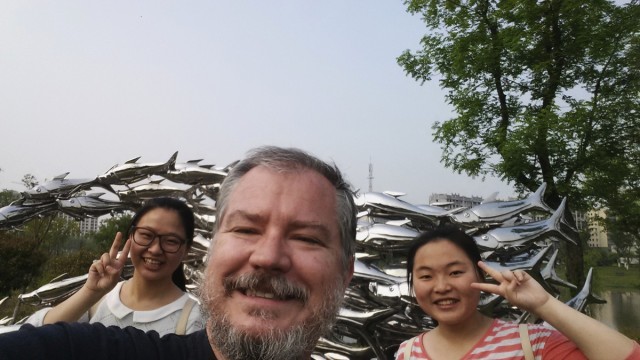
Outside of classes, Sorohan describes Wuhu, which is about 300 miles to the west of the East China Sea, as a fascinating city steeped in centuries of history. However, he says there are also numerous signs of modern Western life surrounding Anhui. In between the Yangtze River and thousand-year-old Buddhist temples, he also recalls seeing McDonald’s restaurants and Wal-Mart stores.
He vividly recounts witnessing hundreds of people gathering in a public plaza next to campus every Friday and Saturday night.
“They would bring boomboxes and just dance all over the place,” he says. “Anyone who showed up could just get involved, in everything from ballroom dancing to what looked like Zumba-style aerobics.”
Beyond the hustle and bustle surrounding the campus, Williams remembers taking a few detours onto the city’s side streets. There, he encountered merchants selling fresh meats and vegetables at open markets and even a few restaurants serving alleyway meals.
Williams says the Wuhu locals, especially the students, were amicable, helpful and inviting people. Nor were all the residents bashful or hesitant to introduce themselves. He remembers visiting a Pizza Hut with Sorohan and encountering a mother and her young daughter, who was extremely enthusiastic to demonstrate her mastery of the lingua franca.
“The little girl shook my hand and her mother was trying to get her to say something in English,” he says, “and she just started singing her ABCs to us.”
‘Two plus two’ equals one
Twenty-seven two-plus-two students are expected to arrive at Brenau in August 2016, with a new group of undergraduates joining the campus each fall term. With Anhui preparing two dozen to nearly 50 graduates a year, an estimated 75 Chinese students will take up residence in Gainesville throughout the academic year once the program is fully implemented.
“For Brenau, it’s going to be wonderful for a variety of reasons,” Sorohan says. “Getting students in the College of Education who have that international education experience is going to be so beneficial, and that comparative perspective on the way things are done in other countries is going to be very valuable for our students.”
The two plus two program, however, is not limited to the College of Education. Anhui is also preparing a cohort of English students for study at Brenau, with a cohort of Anhui University of Chinese Medicine students soon gearing up for nursing courses in the United States.
By 2018, more than 200 students – all of them paying tuition – are expected to be enrolled in the program.
Brenau has plans to send staff and faculty to Anhui every spring and fall. Arts and Humanities instructor Dr. Sonia Robles traveled there in the fall 2015 semester, as did Jordan Anderson, director of programs and services for international students.
“Understanding American teaching methods is a huge learning curve for some international students, so being exposed to our faculty prior to their arrival will give them a significant advantage,” Anderson says.
That exposure, she says, will not just benefit Anhui students. It’s also going to help their professors and classmates at Brenau.
Diversity training for student leaders is already underway. An ambassador program for Anhui incoming students is also in the works.
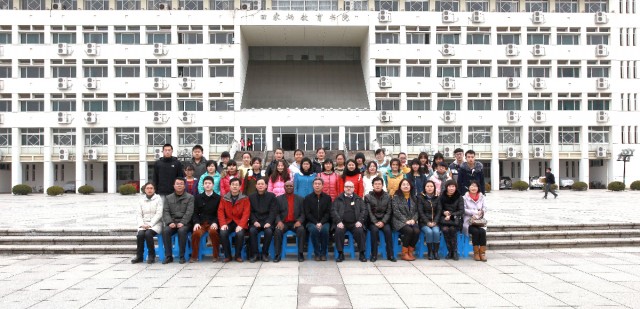
“It’s going to be a fairly comprehensive program that will start in the spring, after we have selected five to seven Brenau students based on an application process similar to that of the peer assistants for FYS classes,” Anderson says. “In May we will we visit Anhui Normal University to meet our incoming students, and the ambassadors will use that time to get to know them and answer any questions the Anhui students may have.”
While the smaller, more intimate educational experience will certainly benefit Anhui transplants, Sorohan also says their arrival on campus will benefit other students, too.
“The opportunity to see different education systems and interact with colleagues and students from another nation is going to be extremely valuable as Brenau develops its international reputation,” he says. “When they interact with students from an entirely different culture, it helps to make their perspectives on the world more fully-formed, and it may give them more of an impulse to study abroad themselves.”
Williams – who made a return trip to China to teach two eight-week courses during the fall semester – says the two-plus-two partnership is truly a win-win arrangement. While Anhui students obviously benefit from the hearty dose of Americanized liberal education, he says Brenau students will benefit just as much from experiencing a different worldview and realizing that, despite their superficial differences, they share many of the same interests and desires.
“The biggest benefit is the exposure of both countries to one another,” he said. “You actually get to talk to people, and you learn that people are just people.”
In today’s global village, Anderson said international experiences are becoming increasingly vital for students. The faculty exchange program, she said, might provide just the spark U.S. students need to immerse themselves in educational experiences overseas and outside the lower 48.
“The reality of our world, and even our corner of Georgia, is that we all have to interact with people from every part of the globe, and from all cultural backgrounds,” Anderson said. “From my perspective, faculty are the greatest resource we have for encouraging students to study and travel abroad, so I hope that as they travel they are sharing their experiences with our students, which will hopefully give them a nudge towards factoring in study abroad as a part of their programs.”
First-hand Perspective
In the gallery below, Dr. Bryan Sorohan describes his experiences in Wuhu, China. All photographs are courtesy of Sorohan and the staff at Anhui Normal University.
- This was the apartment building where I stayed while teaching at Anhui Normal University. It is known as the Expert House. It is located on the Anhui Normal University Campus near the West Gate.
- Morning exercises at the Anhui Normal University Affiliated Kindergarten.
- Kindergarten students going to morning classes at the Anhui Normal University Affiliated Kindergarten. The visits to schools were an important and fun part of my visit.
- This was a demonstration lesson in physical education at the Anhui Normal University Affiliated Kindergarten. The students did all kinds of exercises with automobile tires, including carrying them across the courtyard.
- The teachers at the Anhui Normal University Affiliated Kindergarten were very friendly and welcoming. Miss Zhou (far right), a faculty member at the Anhui Normal University College of Educational Sciences, arranged several school visits for me while I was in Wuhu.
- These students attend a private kindergarten in Wuhu that has a focus on fine arts. They are shown here taking part in morning exercises as the school day began. Our visit included some demonstration lessons in arts instruction and health/physical education.
- The principal of one school we visited demonstrates how to paint Chinese calligraphy. This beautiful example, which says “Your China Dream,” is now on the wall of my office here at home.
- The principal of one school we visited demonstrates how to paint Chinese calligraphy. This beautiful example, which says “Your China Dream,” is now on the wall of my office here at home.
- These students at a private kindergarten in Wuhu are working on creative activities in the classroom. In China, children may enter kindergarten as early as 18 months old and attend until they are 5 years old.
- The local food in China was excellent, but sometimes I wanted a taste of home. There were a number of American fast food restaurants near the university, including McDonald’s, Kentucky Fried Chicken and Pizza Hut. I think the most surprising thing was how little difference there was between a Big Mac in China and one in the U.S.
- The local food in China was excellent, but sometimes I wanted a taste of home. There were a number of American fast food restaurants near the university, including McDonald’s, Kentucky Fried Chicken and Pizza Hut. I think the most surprising thing was how little difference there was between a Big Mac in China and one in the U.S.
- During a weekend trip to Nanjing we had the opportunity to visit the mausoleum of Dr. Sun Yat Sen, who is celebrated as an early revolutionary leader in China. The mausoleum and adjoining park cover many acres of Mount Zinjin (Purple Mountain) just outside the city. Our interpreter Rebecca, a faculty member at Anhui Normal University in the School of Foreign Studies, appears in the foreground carrying a white purse.
- The mausoleum of Dr. Sun Yat Sen is an important cultural destination in Nanjing. This view is from the main building at the top of Mount Zinjin (Purple Mountain). There were thousands of visitors at the mausoleum and the adjoining park that day. Dr. Williams got many requests to pose for photographs with strangers along the staircase.
- One of the most solemn places we visited was the Nanjing Massacre Memorial and Museum, which commemorates the killing of thousands of Nanjing’s residents by the Japanese during World War II. This plaza stands on an area where many of the victims were killed when the city fell in 1937. It’s impossible to visit such a site and not be moved deeply by the suffering that occurred there.
- This photo shows the initial meeting we had with officials from Anhui Normal University on the day after we arrived. I am sitting next to Tianyi (Tiff) Wang, Brenau’s liaison with Anhui Normal University. Some of the Early Childhood Education students are in the background.
- This photo shows a garden and study area on the old campus of Anhui Normal University. This section of ANU was founded in 1928 and is one of the oldest universities in China. In the background, several student dormitories can be seen.
- The beauty of Anhui Normal University’s old campus is on display in this photo of the garden and lake area on campus. It was a common sight to see students relaxing and studying in this beautiful space. To the right, several men’s dormitories can be seen, while the hill and tower in the middle background are a part of Zheshan Park next to the historic campus.
- The ANU College of Educational Sciences generously provided this attractive office space for the use of Brenau faculty who will be visiting the university and teaching classes as part of the two-plus-two program.
- This view of the Brenau Office at Anhui Normal University shows the space provided for student help and conferences. The office was also equipped with a kettle and hot water canisters for making tea. The barred gate visible through the doorway provided security for the recreational area next door used by the College of Educational Sciences faculty, which included a ping-pong table, a room for table games, and a small fitness facility.
- This photo shows one of the magnificent temple buildings at the Guangji monastery, located next to ANU’s old campus. For a small admission price of about 85 cents, visitors can tour the 1100-year-old complex, including a beautiful stone tower overlooking the city that dates to around 1030. This was one of my favorite destinations when I wanted to get away and soak in the peaceful atmosphere.
- One of my students took this photo of me on a visit to Guangji monastery, with its 1100 year-old temple complex. The temple was quite popular with visitors, many of whom came to offer a token such as a ribbon as a tribute to their ancestors.
- This photo shows the staircase leading up from the lower level of Guangji Monastery to the upper area with its 1,000-year-old tower. This staircase was reserved for going up, with two side staircases for walking down. Any visitor unaware of the customs for using the proper staircase could expect a quick correction form one of the older ladies who helped to clean the temple each day.
- I took this photo through the window of our car on the trip from the provincial capital of Hefei to Wuhu and the university. One of the enduring images I have from China is the sight of apartment buildings stretching for miles into the distance near every city like rows of dominoes. Unlike U.S. cities, Chinese cities didn’t have suburban zones around them, but rather long stretches of high-rise apartments. The transition from city to country was very abrupt.
- This view is looking across a large plaza on Anhui Normal University’s South Campus. University administration buildings can be seen in the background to the right, while the high-rise buildings in the distance were mostly housing for faculty members of the university. Everywhere you looked in the Chinese cities we visited there seemed to be multiple buildings under construction, and the large cranes on top of them looked like lines of giant birds sitting on the horizon.
- Anhui Normal University’s newest campus contains an impressive library as well as many classroom and administrative buildings and dormitories. This photo shows custodians from the library rinsing out their mops in the reflective pool that surrounds the library, which was a gift from a wealthy donor to the university.
- This photo shows Dr. Williams and myself along with one of our students, Wu, from Anhui Normal University. We were standing on a sandbar in the Yangtze River next to Tianmen Mountain just north of Wuhu. One of the most delightful surprises of my visit to China was the hospitality and genuine good fellowship shown to us by our Chinese hosts. Without the help of my English-speaking students like Wu, life would have been quite a challenge.
- I took this photo of Wuhu from the top of Tianmen Mountain, along the Yangtze River north of the city. The amazing number of high-rise apartment buildings, along with the fairly abrupt transition from an urban to a semi-rural landscape, can be seen here.
- This is one of many small streets among the apartment buildings and stores of Wuhu where families worked in small businesses. This particular street was a food market with a number of small open-air restaurants as well as food stalls selling produce, poultry (mostly live), and meats. If you wanted a duck, a cut of pork, groceries, or a full stir-fried dinner, this market was the place to go.
- Taken from across the beautiful mirror lake in the center of Wuhu, this photo shows one of the city’s main retail centers. Shoppers could buy the latest designer clothes, electronics and jewelry at the large department stores surrounding a half-mile pedestrian mall. The walk around the lake was a favorite evening activity of many Wuhu residents that I came to appreciate myself.
- This photo shows houseboats along the Quingyi River, which was a small tributary of the Yangtze that divided Wuhu into northern and southern districts. Wuhu’s importance as one of the last Yangtze River ports before Shanghai and the ocean has made it a trading center for literally thousands of years.
- Jack, one of my English students, presented me with this fine calligraphic scroll on a visit to one of Wuhu’s excellent hotpot restaurants. Calligraphy was a hobby for quite a few students, and an interest in traditional Chinese culture was evident among many young people I met. The hotpot restaurant is a favorite in China, especially with students who enjoy a chance to socialize and vary the diet they find at the university dining hall.
- These fresh turtles were on sale at a store selling freshwater foods just a few blocks from the Yangtze.
- Two of my education students, Lily and Belle, took me for a visit to Wuhu’s Sculpture Park just outside of town. The park contains a multitude of sculptures, many of which have won prizes in exhibitions around the region.
- This is a view of Wuhu from the Guangji Monastery. I thought the contrast between the ancient temple roof and the modern construction that characterizes the city today was interesting.
- A photograph showcasing Wuhu’s historical architecture, some of which dates back to the 11th century and earlier.
- In this photo, a tired visitor is carried up the trail at Huangshan in a sedan chair. There was a cable car system to carry visitors most of the way to the top, but manpower was the only method for moving supplies and often people from the cable car station to the facilities and high peaks of the park. Porters carrying impossible-seeming loads on their shoulders with yokes were a common sight along the trails on the mountain.
- Signs along the trails at Huangshan warned visitors not to try to walk the narrow trails while trying to view all of the scenery. While puzzling at first, the need for such a warning became obvious on the mountain peaks, because there was so much beautiful scenery to view in any direction you looked.
- The majesty of the mountain peaks at Huangshan dwarfed the buildings constructed for the park. If you look carefully at this photo, you can see the lines of visitors hiking the trails that led up and down the cliffs.
- On the advice of our driver, Dr. Williams and I booked ourselves on a guided tour of the mountain trails at Huangshan. Although we weren’t able to understand most of what our guide said, we learned that following someone who knew their way around the confusing trails was a good idea. The hats we’re wearing in the photo identified our tour group, which was only one of dozens on the mountain that day.
